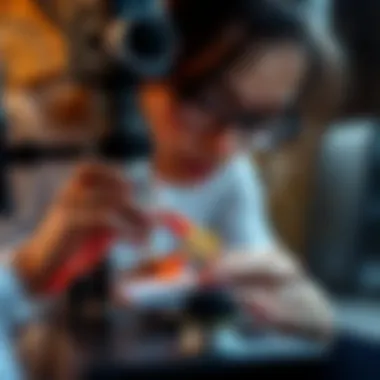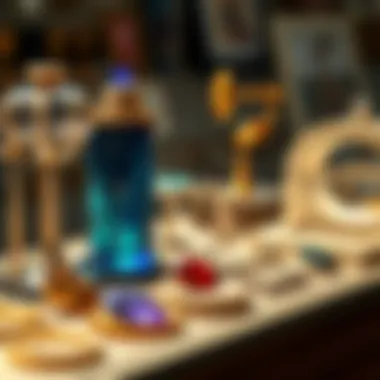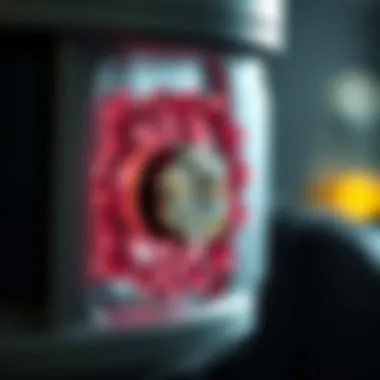The Essential Role of Jewelry Testers in Gemstones


Intro
In the world of gemstones, the beauty and allure of each stone often overshadow the critical processes that underpin their evaluation and authentication. Jewelry testers serve as the unsung heroes, ensuring that what glitters is indeed gold—or, more appropriately, genuine gemstones. Their role extends beyond mere identification; they are pivotal in quality assurance, helping to safeguard both consumer trust and market integrity.
With the rise of synthetic gemstones and imitation stones flooding the market, an understanding of jewelry testers’ tools and methodologies is not merely useful, but essential for anyone engaged in gemstones—be it collectors, designers, or enthusiasts. This introductory section lays the foundation for a deep dive into the indispensable nature of jewelry testers in the gemstone industry.
Gemstone Overview
Description of the Gemstone
Gemstones are not just pretty face; they are minerals that have undergone a meticulous journey, often involving a combination of geological processes and human craftsmanship. From the dazzling depths of the earth, these stones emerge in a myriad forms, colors, and sizes.
Take a diamond, for instance—formed under immense pressure and high temperature. It's renowned for its brilliance and hardness, often symbolizing wealth and commitment. On the other hand, a vibrant emerald, with its rich green hue, captures the eye but comes with its own set of optical and physical properties that make it quite soft by comparison. Understanding these characteristics is fundamental for anyone in the gemstone business.
Physical Properties
The physical attributes of gemstones play an integral role in their evaluation.
- Hardness: Measured on the Mohs scale, it ranges from 1 (talc) to 10 (diamond). Each level indicates the scratch resistance.
- Refractive Index: This indicates how light bends when it enters the gem, affecting the stone's brilliance.
- Specific Gravity: This measures the weight of the gemstone relative to the weight of an equal volume of water.
Understanding these properties not only aids in identifying gemstones but also in using the right jewelry testing equipment to avoid potential mix-ups or misjudgments.
The line between a genuine gemstone and a well-crafted imitation can often be as thin as a whisper, but the impact of misidentification is a resounding echo in market dynamics.
As we move through this article, we will explore the tools that jewelry testers wield as well as the methodologies they employ to ensure quality and authenticity, shedding light on the critical underlying processes that uphold the gemstone industry.
Foreword to Jewelry Testing
In the ever-evolving world of gemstones and jewelry, one thing remains constant: the need for testing to ensure quality and authenticity. As consumers become more discerning, the demand for reliable methods of testing gemstones increases. A piece of jewelry isn’t just a sparkly adornment; it embodies value, emotion, and artistry. To comprehend the layers of importance embedded within the jewelry we wear, one must appreciate the role of testing in unveiling its true nature. Without a doubt, testing is the unsung hero of the jewelry industry, paving the way for trust and confidence among jewelers and consumers alike.
Understanding the Importance of Testing
Testing jewelry serves a multitude of purposes. First and foremost, it acts as a safeguard against fraud. In an industry where imitation is rampant and fakes can often fool even the most seasoned gemologist, testing verifies that every stone shines with its rightful worth. Imagine purchasing a stunning piece of jewelry only to find out later that the emerald is actually a cleverly crafted piece of glass. Testing mitigates such unpleasant surprises and keeps the integrity of the market intact.
Furthermore, accurate testing fosters consumer trust. Jewelers who can confidently provide documented results from jewelry testers enhance their reputation, not just for honesty but for quality. Customers are more inclined to invest when they know the authenticity of their purchases has been confirmed with precision. Ultimately, whether it’s a budding enthusiast or a seasoned collector, effective testing lays the foundation for informed decisions and peace of mind.
The Role of Jewelry Testers
Jewelry testers are the backbone of quality assurance. These tools range from simple handheld devices to sophisticated machines, each designed for specific testing purposes. It’s a world where technology meets tradition, as both gemologists and designers rely on the accuracy feedback these tools provide. Consider the refractometer, which delves into the gemstone's refractive index, offering insights crucial in distinguishing between different types of gems. Other tools, like spectroscopes, reveal a spectrum of light that can unveil a stone's intrinsic properties.
With the advent of electronic testers, traditional methods are being enhanced, allowing for faster and more precise outcomes. A jeweler can now determine whether a piece is crafted from gold, silver, or an altogether different metal with just a touch of a button. These advancements foster efficiency and accuracy, both vital in a fast-paced market.


In summary, jewelry testing weaves assurance, quality, and authenticity into the fabric of the gemstone industry. By understanding its significance and the role of testers, one can appreciate the nuanced journey from raw gemstone to a beautifully designed piece of jewelry. Together, these elements create a robust framework that is vital for the thriving ecosystem of gemstones and jewelry.
Types of Jewelry Testers
The realm of gemstones and jewelry is rife with intricate details that define the quality and authenticity of each piece. The utilization of jewelry testers emerges as a non-negotiable element in this industry, possessing a multifaceted role in ensuring that consumers receive only the best. Various types of jewelry testers are designed to address distinct testing needs, from identifying gemstones to verifying precious metals. Each of these tools carries its own unique characteristics that make them indispensable for both industry professionals and hobbyists alike.
Gemstone Testing Tools
Gemstone testing tools are crafted to assist in the identification and analysis of various gemstones. They provide crucial information on a gemstone's optical properties, enhancing the buyer's knowledge and ensuring that they make informed decisions. Each tool comes with specific advantages that can affect both the ease of use and accuracy of testing, influencing the entire process of gemstone verification.
Refractometers
Refractometers are essential instruments used to measure the refractive index of gemstones. This critical characteristic aids in identifying gemstones accurately. A significant trait of refractometers is their precision; they can offer exact readings, allowing for better gemstone appraisal. Their accuracy makes them a popular choice in the industry, as they reveal definitive properties of stones that help distinguish one from another. However, one should note that refractometers may require some practice to use effectively, which could be a hurdle for newcomers.
Color Filters
Color filters are vital in discerning the hues of gemstones, particularly when it comes to identifying synthetic versus natural stones. The key characteristic that sets color filters apart is their simplicity in application. They can quickly show how light interacts with different materials, highlighting gemstone clarity and color saturation. Their affordable price point also makes them an attractive option for enthusiasts. One downside, however, is that color filters alone do not provide comprehensive information about the internal structure or possible treatment of the gemstone.
Spectroscopes
Spectroscopes enable the practitioner to analyze the light spectrum emitted or absorbed by gemstones. This allows for a deeper understanding of the stone’s composition. What stands out with spectroscopes is their ability to reveal even minute details about gemstones that might go unnoticed by the naked eye. This level of insight positions them as a favored option among gemologists. On the flip side, the learning curve associated with interpreting the data can be somewhat steep for those not familiar with spectrometry.
Precious Metal Testers
When it comes to the precious metals used in jewelry design, testing tools are equally critical. Accurate identification of metal types and their purity ensures that consumers are not getting shortchanged. The methods employed for testing precious metals also play a significant role in defining the trustworthiness of a piece.
Acid Tests
Acid tests are traditional methods used to determine the karat of gold or the purity of silver. The key trait of this method is its straightforward approach. A small scrape is made on the metal, which is then applied with a specific acid. The reaction between the acid and the metal gives insights into its purity levels. Acid tests also boast the advantage of being highly effective and relatively fast. However, they may potentially damage the item, making them less suitable for high-value pieces.
Electronic Testing Methods
Electronic testing methods have gained traction due to their non-invasive nature. These devices work by passing electrical currents through the metal, generating readings that confirm purity. A notable advantage is that they leave the jewelry intact, thus preserving its aesthetics and rare qualities. Additionally, they are generally easy to operate, appealing to novice testers. Nevertheless, the initial cost of these electronic devices can be quite high, which might be a barrier for some.
Accurate testing is not merely a formality; it's a pledge to quality in the gemstone and jewelry industry.
With an understanding of the various types of jewelry testers available, buyers, sellers, and collectors can better navigate the complexities of gemstones and precious metals. The diversity of tools increases the likelihood of achieving accurate results, thereby strengthening both market standards and consumer confidence.
Significance of Accurate Testing
In the realm of jewelry making, accuracy is not just a bonus; it's the backbone of the entire industry. High-caliber testing ensures that gemstones and precious metals meet the expected standards of quality and authenticity. When considering the significance of accurate testing, it's easy to see how it plays a vital role in several key areas.
Some of the specific elements and considerations include:


- Health of the Retail Market: A reliable gemstone enhances market trust. Jewelers and consumers alike feel safer knowing their purchases are genuine and properly evaluated.
- Avoidance of Fraud: Accurate testing is a robust defense against fraud. Counterfeit gemstones can overshadow the market, but effective testing exposes them. This keeps the integrity of high-value transactions intact.
- Sustainability of the Craft: Jewelers who maintain high standards of testing set themselves apart. This commitment can make or break a reputation in a field where trust is invaluable.
Quality Assurance in Jewelry Making
Quality assurance in jewelry making hinges on the meticulous procedures employed during testing. Accurate results do more than just reassure the buyer; they also serve the creator. When jewelry designers use well-tested materials, they can focus on their craft, allowing for better innovation and creativity.
This quality control begins at the source. For example, a gemstone that is poorly tested may lead to subpar final products. Jewelers risk not only their financial investment but also their reputation if they sell items that don’t meet customer expectations. The focus on reliability demands the use of specific tools that highlight the unique characteristics of each piece. Commonly utilized tools like refractometers and spectroscopes aid in identifying not only the gemstone’s origin but also its value.
Further repercussions of accurate testing are felt in traditional jewelry-making environments as designers can bring their visions to life while adhering to the highest standards. Essentially, accurate jewelry testing affirms the entire chain from extraction to retail.
Investor Confidence and Market Impact
Investing in jewelry often requires a leap of faith. Buyers are not just purchasing a piece; they are investing money, emotions, and trust into something they likely hope to cherish or even pass down as heirlooms. This trust is amplified when accurate testing protocols are in place.
When jewelry testers are employed effectively, they foster a more transparent market that reassures investors. Knowing that a gemstone has been thoroughly vetted adds intrinsic value, which can influence their market perception.
Consider the ripple effect: When one buyer feels confident about their purchase, they’re likely to advocate for the product, leading to increased interest and sales. Conversely, a single incident of inauthenticity can taint a brand's reputation and, at times, whole markets. Consequently, the role of jewelry testers extends beyond mere functionality; they are essential for sustaining investor confidence and positively impacting the market.
"Accurate testing is the invisible backbone of trust in the gemstone industry."
As the industry progresses, the implications of accurate testing continue to develop. Jewelers who prioritize integrity and quality assurance inevitably contribute to a healthier and more robust market overall.
Challenges Faced by Jewelry Testers
In the intricate tapestry of the gemstone industry, the role of jewelry testers is pivotal—not just for verifying the authenticity of gems but for ensuring the overall integrity of the jewelry itself. However, this task is not without its challenges. As the marketplace evolves and consumer demands intensify, those who test jewelry face a slew of hurdles that complicate their work. Identifying these challenges is crucial, as it paints a fuller picture of the landscape in which jewelry testers operate.
Evolving Standards and Technologies
The pace of change in the jewelry industry can feel like running a marathon with obstacles. New standards emerge as technology advances, which can often leave testers scrambling to keep pace. For instance, as synthetic gemstones flood the market, differentiating them from natural stones requires not mere intuition but advanced techniques and tools.
Furthermore, regulatory bodies often implement new guidelines for testing methods and equipment. Just when a tester feels comfortable with their skills or instruments, they may find themselves needing to adapt to new regulations and standards just introduced. This continuous evolution necessitates a commitment to staying informed and possible investment in new technologies, which can strain resources—both financial and time-wise.
- Impact on Test Results: Inconsistent standards can lead testers to receive training that might not align with the latest practices, increasing the risk of misidentification.
- Costs: The need for new equipment or training can impose hefty price tags that smaller jewelry businesses might struggle to manage.
- Adaptability: Testers are required to be flexible, learning on-the-go to adapt to technological advancements while also mastering the skills of manual testing.
"In an era where consumer confidence is dwindling, clear and consistent standards become not just a need, but an unequivocal necessity for those in the jewelry testing domain."
Training and Skill Development
Another area where challenges loom is the complexities surrounding training and skill development. The knowledge of gemology is ever-expanding, with new discoveries and methodologies arising frequently. Jewelry testers must continually enhance their understanding, be it through formal education or self-driven research.
Here are a few significant hurdles in this area:
- Accessibility of Education: While there are numerous courses available, not all are practical or affordable. Jewelry testers often find themselves in a bind concerning which programs or educational resources to pursue that would truly add value to their daily work.
- Hands-On Experience: Beyond theoretical knowledge, practical experience is invaluable. Testers frequently seek opportunities to work with rare or unique stones to broaden their skills, which may not always be available.
- Retention of Knowledge: The vast amount of information that testers must absorb and retain can be daunting. Finding effective ways to master knowledge while doing the physical work of testing is a balancing act many testers struggle with.


In summary, the actuating factors at play in the challenges faced by jewelry testers encompass an ever-evolving regulatory environment and the ongoing necessity for education and skill advancement. The ability to adapt and thrive in these challenging circumstances is what sets apart the proficient tester from the rest. Their persistence not only ensures the authenticity of the gemstones but helps maintain the trust of consumers and the integrity of the jewelry industry.
Future Trends in Jewelry Testing
The landscape of jewelry testing is on the brink of a transformation. As technology advances, so does the necessity for accurate, efficient, and trustworthy methods in the gem and jewelry industry. The future trends in jewelry testing are crucial not only for ensuring quality but also for fostering trust among consumers and professionals alike. By delving into these trends, stakeholders can better prepare for imminent changes, potentially elevating the industry's standards.
Integration of Advanced Technologies
Artificial Intelligence
Incorporating Artificial Intelligence (AI) into jewelry testing stands out as a game changer. AI algorithms can analyze gemstone properties with an accuracy that surpasses human capabilities. By examining minute details through machine learning processes, testers can shortlist possibilities of gemstone authenticity in a fraction of the time it would typically take.
A key characteristic of AI is its ability to learn from vast datasets. AI systems can quickly adapt and optimize testing protocols based on previous results, making the testing process faster and more reliable. This adaptability is why AI is increasingly favored in the jewelry assessment realm.
One unique feature of AI in this context is its predictive analysis capabilities. It can forecast potential discrepancies in gemstone quality or authenticity based on patterns recognized in previous testing. The advantage here lies in proactively addressing issues rather than reacting to them after the fact. However, it’s worth noting that while AI tools can provide substantial support, they might not fully replace the nuanced judgment of a seasoned gemologist.
Blockchain for Authenticity
Blockchain technology surfaces in discussions around authenticity and trust in the jewelry industry. By recording each gemstone's journey—from the mine to the end consumer—blockchain creates a verifiable digital trail. This transparency is vital in an industry where counterfeit products pose a significant threat.
A notable characteristic of blockchain is its decentralized nature. Once data is entered into the blockchain, it is nearly impossible to alter it without consensus, which bolsters the trust between buyers and sellers. As consumers become more educated and discerning, having detailed provenance information via blockchain can be a significant selling point in the market.
Unique to blockchain is its ability to ensure that every transaction is dated and logged, which can help resolve disputes regarding authenticity or ownership. The solution offers advantages in terms of security and trust but may also face adoption challenges due to technical complexity and the need for cooperation across different stakeholders in the jewelry supply chain.
The Rise of DIY Testing Options
An emerging trend in jewelry testing is the rise of Do-It-Yourself (DIY) testing options. Today, gemstone enthusiasts and collectors often seek to empower themselves with knowledge and tools that are accessible and user-friendly. This democratization of testing not only increases awareness but also enhances consumer confidence.
DIY testing kits equipped with basic tools, like magnifying glasses and testing acids, allow collectors to perform preliminary assessments with ease. Moreover, as educational resources proliferate online, individuals can learn to interpret results effectively. Still, while these options promote independence, they don’t substitute the expertise found in professional testing.
The growing trend toward DIY testing reflects a shift in consumer engagement in the gemstone sector. As intuitive tools become more prevalent, the lines between amateurs and professionals blur, paving the way for a more informed jewelry community.
Closure
The role of jewelry testers in the gemstone industry cannot be overstated. They represent a vital link between the raw beauty of a gemstone and the trust that consumers place in jewelry. As we've explored throughout this article, the testing process not only assures quality but also defines the standards by which stones are bought and sold in the market.
The Indispensable Nature of Jewelry Testers
Jewelry testers are more than just tools; they are the backbone of credibility in this business. Consider the implications of an untested gemstone. If the authenticity is called into question, both gem collectors and designers face significant repercussions. Inaccurate evaluations can lead to losses, undermine trust, and create confusion for customers.
"In the world of gemstones, knowledge truly is power. Jewelry testers empower makers and buyers alike to make informed choices."
Here are a few specific points underscoring their importance:
- Quality Assurance: Jewelry testers ensure that gems meet industry standards, steering clear of counterfeits that may mislead buyers.
- Market Impact: By verifying the authenticity and value of gemstones, testers enhance investor confidence, which is crucial for maintaining stability in fluctuating markets.
- Educational Growth: With advancements in technology, testers are proving indispensable in the education of gemmologists and jewelry designers alike. Their ability to accurately identify materials promotes a deeper understanding of gemstone characteristics and valuation.
Moreover, the integration of new technologies such as spectroscopes and refractometers has transformed traditional testing methods. The shifting paradigms also reflect a need for ongoing education. Those involved in jewelry craft must adapt continually, learning how to leverage new tools while adhering to evolving standards.
In summary, jewelry testers serve a fundamental role in maintaining the integrity of the gemstone industry. They fortify trust, bolster quality assurance, and pave the way for future developments in gemstone verification. As we move towards a more technology-driven market, their importance is set to rise even higher.







